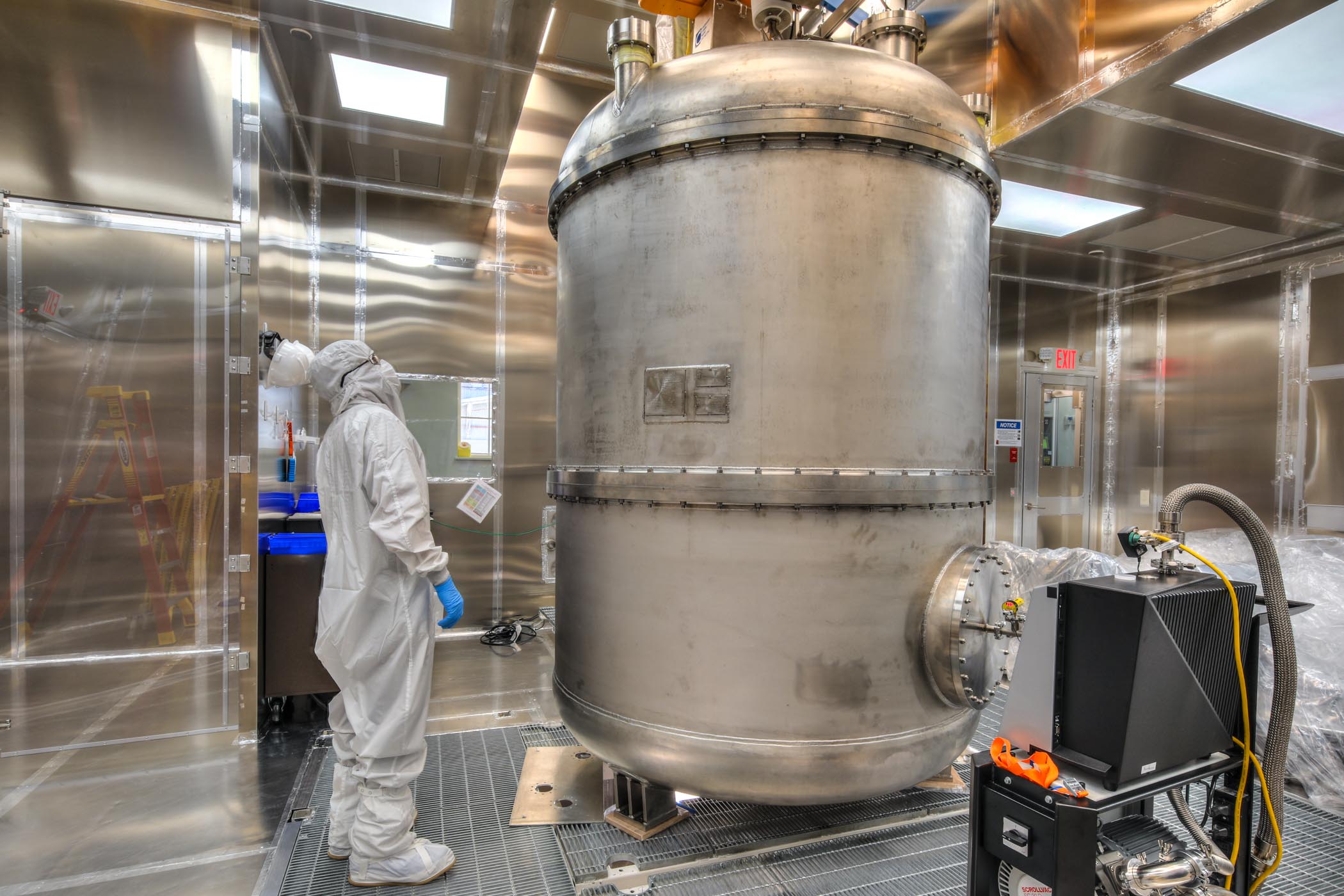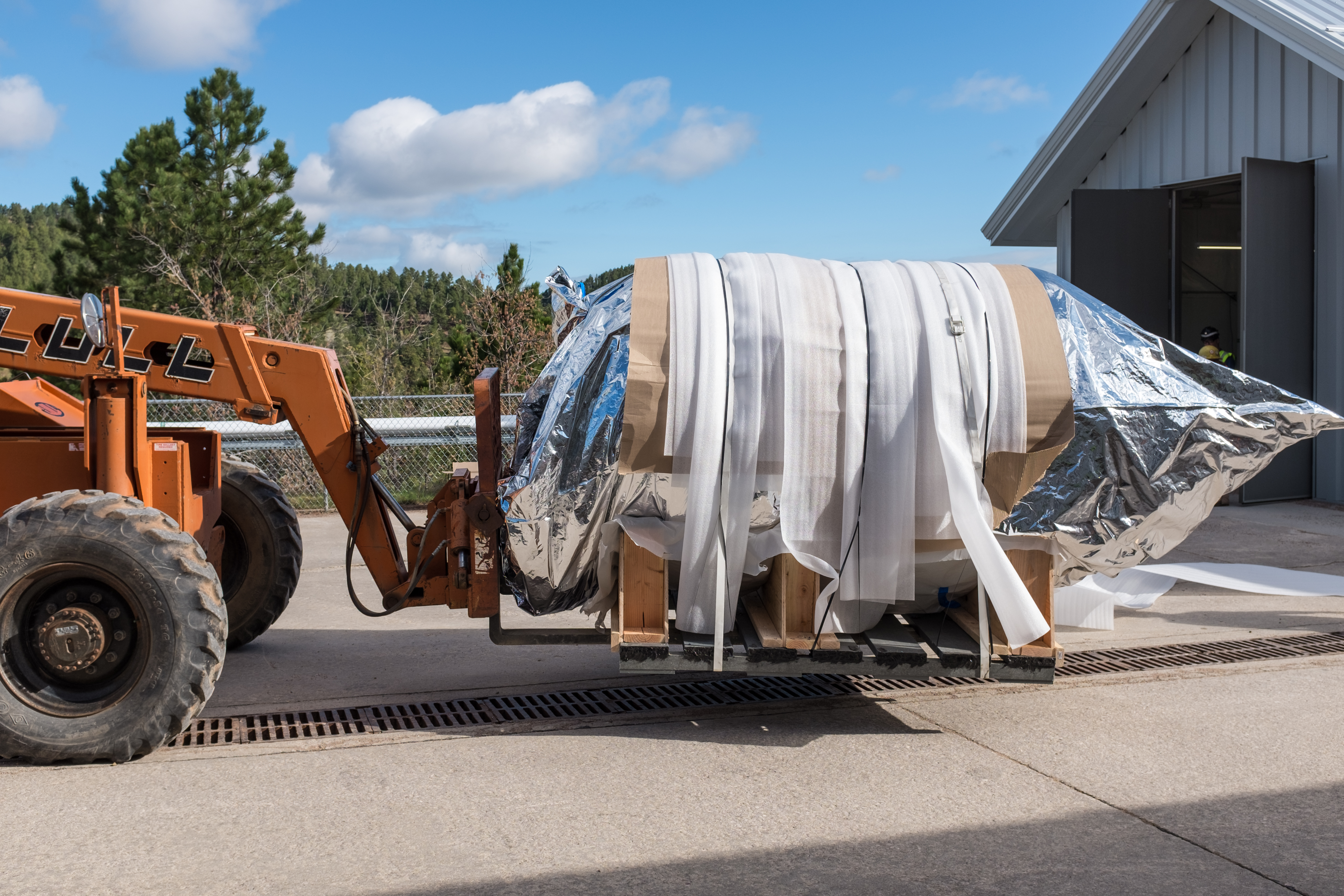
A worker inspects the titanium cryostat for the LUX-ZEPLIN experiment in a clean room. (Credit: Matt Kapust/SURF)
Note: This article is adapted from a press release by the U.K. Science and Technology Facilities Council. View the original release.
A large titanium cryostat designed to keep its contents chilled to minus 148 degrees has completed its journey from Europe to South Dakota, where it will become part of a next-generation dark matter detector for the LUX-ZEPLIN (LZ) experiment.
The U.S. Department of Energy’s Lawrence Berkeley National Laboratory (Berkeley Lab) is leading the LZ project, which is expected to be completed in 2020. About 200 scientists and engineers from 39 institutions around the globe are part of the LZ collaboration.
When it starts operations, LZ will be the largest experiment to hunt for the long-theorized, elusive dark matter particles called WIMPs (weakly interacting massive particles). Many scientists believe finding WIMPs will provide the answer to one of the most pressing questions in physics: What is dark matter?
Dark matter makes up about 85 percent of the matter in the universe. But because WIMPs are thought to interact with normal matter only very feebly, they are practically invisible using traditional detection methods. LZ will be at least 100 times more sensitive to finding signals from dark matter particles than its predecessor, the Large Underground Xenon experiment, or LUX.
The cryostat chamber, which arrived in South Dakota on May 14, was built by a team of engineers at the U.K. Science and Technology Facilities Council’s (STFC) Rutherford Appleton Laboratory in Oxfordshire, England. The cryostat will ultimately reside, along with the detector and other associated equipment, nearly a mile underground at the Sanford Underground Research Facility (SURF) in Lead, South Dakota.
The arrival at SURF marks a significant milestone in the LZ project, as the cryostat is several years in the making and is a key component in the experiment.
After being delivered to the surface facility at SURF, the outer cryostat vessel of the cryostat chamber spent five weeks being fully assembled and leak-checked in the SURF Assembly Lab (SAL) clean room. It has now been disassembled and packaged for transportation from the surface to the underground location at SURF. The inner cryostat vessel is now in the SAL clean room getting prepared for the leak tests.
“It’s a great experience to see all of the planning for LZ paying off with the arrival of components,” said Murdock “Gil” Gilchriese, LZ project director and a Berkeley Lab physicist. “We look forward to seeing these components fully assembled and installed underground in preparation for the start of LZ science.”
STFC’s Pawel Majewski, technical lead for the equipment, said, “The cryostat was a feat of engineering with some very stringent and challenging requirements to meet.” The cryostat weighs about 2.2 U.S. tons and was made of ultrapure titanium to avoid interference with possible WIMP signals.
“It took nearly two years to find a pure enough sample to work with,” Majewski said. “Eventually we got it from one of the world’s leading titanium suppliers in the U.S.” An electron beam technology was used to melt the titanium.
The cryostat works in a similar way to a big thermos flask and keeps the detector at freezing temperatures. This is crucial because the detector uses xenon – which at room temperature is a gas. For the experiment to work, the xenon must be kept in a liquid state, which is only achievable at about minus 148 degrees.
Highly purified liquid xenon will be used as the medium for WIMP detection in LZ because it has a very low background radiation, making it easier to spot any rare interactions involving WIMPs.
Liquid xenon atoms emit a flash of light when struck by a particle, and this light can be detected by very sensitive photon detectors called photomultiplier tubes. If a WIMP collides with a xenon nucleus, it is expected to produce a characteristic burst of light.
The experiment will use 10 tons of liquid xenon held in the titanium cryostat. Because WIMPs are so hard to detect, the cryostat’s titanium and other materials must have an extremely low radiation background so they will not interfere with the experiment.

The inner cryostat vessel is off-loaded from a truck at the Sanford Underground Research Facility in South Dakota. (Credit: STFC)
Since the project’s inception in 2012, STFC has been in charge of the design and the delivery of the cryostat. The engineering effort has been led by Joseph Saba, a Berkeley Lab mechanical engineer, and Edward Holtom of STFC’s Technology Department.
Majewski said, “The cryostat was a feat of engineering, with some very stringent and challenging requirements. Because of its huge mass (about 2.2 tons), we had to make sure it was made of ultrapure titanium or it would overwhelm the detector with background radiation. It took more than two years to find titanium pure enough to work with.”
He added, “This type of ultrapure titanium is used, for example, in the health care industry to fabricate pacemaker encapsulations. In our case it is used to hold the heart of the experiment.”
It took 2 1/2 years to design the specialized equipment, and another two years to build.
Loterios (Titanium Metal Corp.) in Italy was commissioned to create the finished vessels from a five-ton slab. Following manufacturing, the cryostat was chemically etched and precision-cleaned by Astro Pak Corporation at their Downey, California, clean room facility prior to shipment to SURF.
The cryostat is the U.K.’s largest contribution to LZ but is not the only contribution. STFC is also supporting work on LZ’s calibration hardware, photomultiplier tubes, internal monitoring sensors, and materials screening, and is supporting one of the LZ data centers.
Professor Henrique Araújo of Imperial College London, who is the U.K.’s principal investigator for LZ, said, “It is incredibly gratifying to see LZ beginning to take shape. Seeing the cryostat arrive is a milestone moment as it has been years in the making. This is the first big piece around which we will build the rest of the experiment.”
There are still many LZ components yet to be assembled and tested. The experiment is expected to start taking data in 2020.
Upgrades of the underground Davis cavern at SURF, where LZ will be installed, are in progress and will be completed by August, Gilchriese said, and large acrylic tanks that will help to validate LZ measurements are expected to arrive at SURF by September.
Major support for LZ comes from the DOE Office of Science, the South Dakota Science and Technology Authority, the UK’s Science & Technology Facilities Council, and by collaboration members in South Korea and Portugal.
More info:
###
Lawrence Berkeley National Laboratory addresses the world’s most urgent scientific challenges by advancing sustainable energy, protecting human health, creating new materials, and revealing the origin and fate of the universe. Founded in 1931, Berkeley Lab’s scientific expertise has been recognized with 13 Nobel Prizes. The University of California manages Berkeley Lab for the U.S. Department of Energy’s Office of Science. For more, visit www.lbl.gov.
DOE’s Office of Science is the single largest supporter of basic research in the physical sciences in the United States, and is working to address some of the most pressing challenges of our time. For more information, please visit the Office of Science website at science.energy.gov.